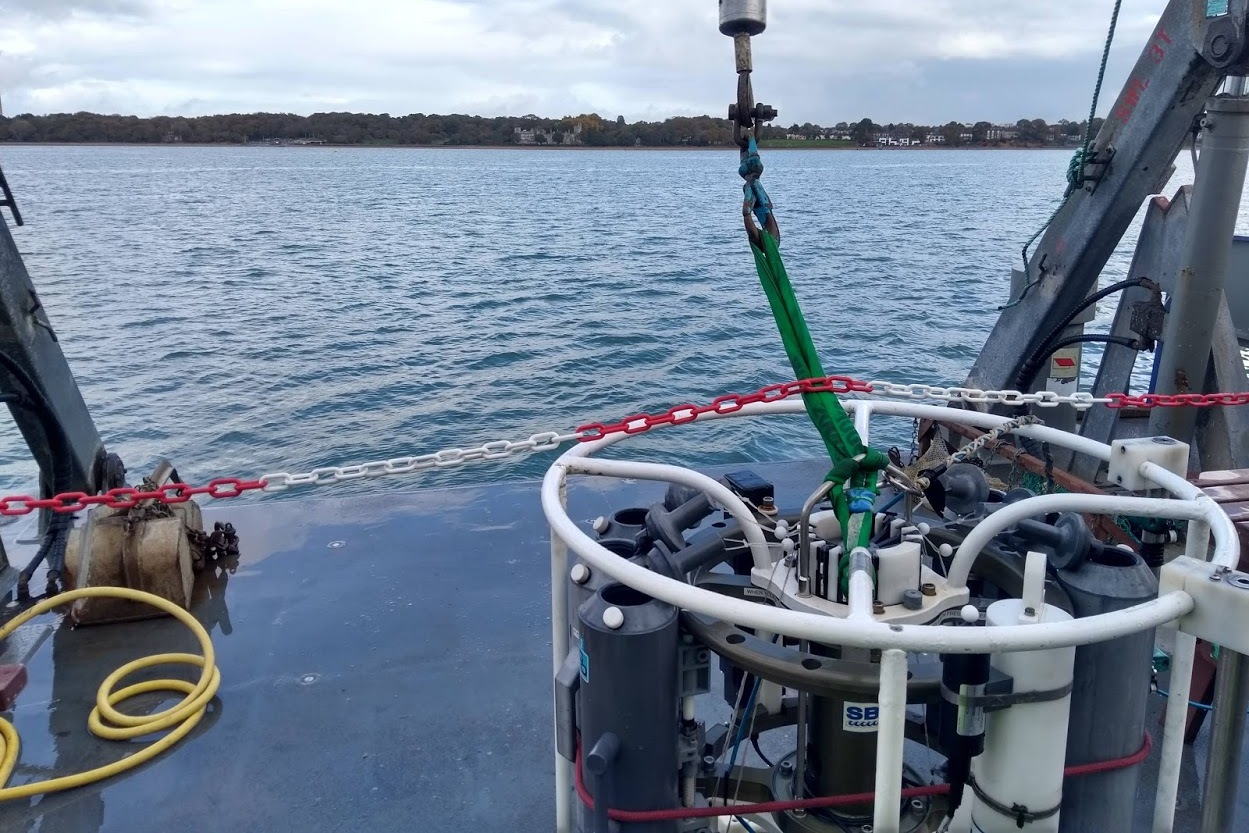It's CTD Appreciation Day! Why CTDs are a big thing and SHOULD be celebrated
Posted on January 22, 2021
Each year on the 22nd January, CTD Appreciation Day is celebrated by marine scientists around the world, mostly on Twitter via the hashtag #CTDAppreciationDay. But why? Well, they form the basis of a large proportion of modern oceanographic measurements. So what are CTDs and how are they used?

Left - SBE MicroCAT CTDs for moorings. Right - CTD rosette on board the RV Callista, Southampton Water. Photos my own.
CTDs are a measurement device with three sensors, although the CTD itself is commonly complemented by a host of other sensors and equipment. CTD is an acronym of the individual sensors: C for conductivity, T for temperature and D for depth. Conductivity is an important measurement as it is a way of measuring the salinity (salt content) of seawater. The CTD sends out electrical pulses between two conductors, separated by the seawater. A properly calibrated sensor can convert the electrical conductivity of the water into a salinity value. The greater the conductivity, the greater the salinity. Temperature is measured by using a precise digital thermometer. Depth is measured through seawater pressure.
CTDs come in many shapes and sizes, making them a very versatile piece of equipment. Their most common use is for ocean water column profiling. CTDs can be mounted on a rosette - a cylindrical metal frame - and lowered from a ship through the water column. The rosettes are usually kitted out with another oceanographic staple: the Niskin bottle; and other sensors such as light and chlorophyll can also be mounted at the same time.
It's #CTDAppreciationDay! This workhorse of #oceanography collect water samples, measures temperature and salinities, and much more.
— Dr Dan Jones 🇦🇶 🌊 👨💻 (@DanJonesOcean) January 22, 2021
Here's an in-depth blog post by @ErikMackie on this amazing bit of kit from a 2016 cruise:https://t.co/SLKMD0Pq4F#fieldworkfriday #fieldwork pic.twitter.com/b7pQP6vcSe
Another way of utilising CTDs for profiling is through Argo floats. These drifting floats go from surface to 2000m by altering their buoyancy using a hydraulic bladder. A profiling cycle typically lasts around 10 days. Once at the surface, the floats can send the data back to land-based scientists via a satellite connection. There are also "Deep Argo" floats have been developed and deployed, which can go to 6000m. Using Argo and similar profiling/drifting floats has helped fill a gap in measurements where research vessels have not visited or where time series data does not exist.
Today's map of the 3885 CTDs deployed on Argo Floats bringing you sweet, sweet temperature, salinity and pressure data#CTDAppreciationDay pic.twitter.com/me3DqqnH2j
— Dr. Kim Martini 🏳️🌈 (@rejectedbanana) January 22, 2021
Ocean profiling is not the only use of CTDs. They can be mounted on oceanographic moorings, such as the RAPID array, to provide a time series of changes at a certain point. The tweets below show SBE MicroCAT CTDs, which have internal batteries and memory and are clamped directly onto a mooring wire at pre-set intervals. 18 months later, the moorings are recovered and the stored CTD data can be downloaded.
#CTDAppreciationDay here's a few dozen CTDs from a @RAPID_AMOC on the Ron Brown in 2012 pic.twitter.com/F1MwyEwUB6
— Gerard McCarthy (@ger_the_sea) January 22, 2021
It's #CTDAppreciationDay! A key instrument in oceanography, measuring Conductivity (Salinity), Temperature and Depth. Often mounted on a rosette for depth profiles, or on moorings to provide a time series; such as these from my @RAPID_AMOC experience in March. pic.twitter.com/qqw2zQXAIG
— Matt Clark (@Ocean_MattC) January 22, 2021
CTDs can also be mounted onto other apparatus such as towed samplers, autonomous samplers and remotely operated vehicles. Of course, I can't possibly cover every use for CTDs and I'm sure there will be many more inventive ways to use them. As a final thought, let's not forget the scientists, technicians and ship crew who go out in almost all conditions and deploy and recover these most cherished of oceanographic instruments.
Back to top ↑ Blog Home Website HomeHappy #CTDAppreciationDay ! And let's also appreciate the brave souls who deploy and recover them, even in the most challenging of conditions! Here the awesome deck crew of RRS James Clark Ross recover a CTD in the dark, in a blizzard..... @BAS_News pic.twitter.com/66HUCA4MwB
— 🌊 Prof. Michael Meredith ❄️ (@meredith_mmm) January 22, 2021